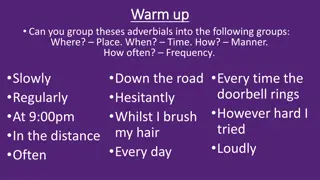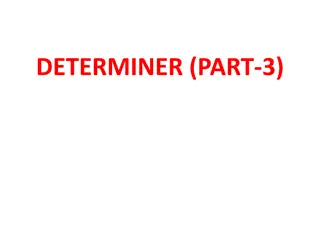Understanding Determiners: Articles and Demonstratives in Different Languages
Explore the concept of determiners, focusing on articles and demonstratives in various languages. Learn about the differences between definite and indefinite articles and how they impact specificity and familiarity. Discover how languages without articles distinguish through word order. Engage in activities to enhance your understanding of determiners in sentence structures.
Download Presentation

Please find below an Image/Link to download the presentation.
The content on the website is provided AS IS for your information and personal use only. It may not be sold, licensed, or shared on other websites without obtaining consent from the author. Download presentation by click this link. If you encounter any issues during the download, it is possible that the publisher has removed the file from their server.
E N D
Presentation Transcript
Language Awareness for Key Stage 3 8: Determiners 1
Roadmap Today we will take a closer look at another part of speech: determiners As you saw before, this category includes articles (a, the) and demonstratives (this, that) We will see how different languages have different articles and use them in different ways We will also look at different types of demonstratives Finally, we will look at agreement between determiners and nouns 2
Articles In English there are two types of article, the indefinite article (a/an) and the definite article (the) You may remember, though, that not all languages have both types of article 3
Articles 1. a book the book 2. leabhar an leabhar 3. bir kitap kitap 4. liber liber (English) (Irish) (Turkish) (Latin) 4
Articles What do languages with no articles do? One way to make the same distinctions is with word order, as in Finnish 5. Lauloi lintu sang bird A bird sang 6. Lintu lauloi bird sang The bird sang 5
Articles The difference between the indefinite and definite articles is not easy to describe In general, using the definite article means that something is more specific or better known than with the indefinite article 7. Have you seen a dog? (any dog) 8. Have you seen the dog? (my dog, the dog that you know I have) 6
Articles In some contexts, only one article is possible 9. Sorry I m late; a man outside kept me talking 10.Sorry I m late; the man outside kept me talking When you re introducing something completely new, you usually need to use the indefinite article 7
Activity Look at the sentences below See if you can describe what makes them odd 11. John is going to become a chef but we don t know which chef 12. Mary wants to marry a Swede with ten children but she s almost given up hope of finding one 13. Every morning I read the newspaper and by now I almost have it memorised 14. Mrs Smith has been fifty years at this school as the headmaster s wife but none of our headmasters has lasted longer than ten years 8
Solution 9
Solution Both the definite and the indefinite article can have specific or non-specific senses Specific: e.g. the headmaster = the individual who currently happens to be headmaster Non-specific: e.g. the headmaster = the current headmaster, whoever he may be We usually use the context to decide which sense is intended, but sometimes both senses are still possible 10
Articles Another difference is that the indefinite article is used only with count nouns (e.g. an icicle, a lawn, a dream) and not with mass nouns (e.g. ice, grass, dreaming) Because of this, mass nouns in English are often found without any article at all 15.There s ice all over the roads this morning 16.There s an ice all over the roads this morning 17.There s the ice all over the roads this morning 11
Articles However, it s still possible to use the definite article with mass nouns when they refer to something known 18.The ice made it hard to drive You can also add the indefinite article to a mass noun, but if you do you re saying that it actually can be counted 19.a coffee (e.g. a cup of coffee , a type of coffee ) 12
Articles There are some languages that have even more articles than English For example, French has a partitive article used with mass nouns and plurals 20.du th tea 21.un th des th s a tea teas 22.le th les th s the tea the teas 13
Articles The partitive article is formed with the preposition de of , usually together with the definite article You can see this most clearly in the feminine form 23.Je buvais de l eau I was drinking water (literally, I was drinking of the water ) The idea behind the partitive article is that this quantity is a small part of a larger whole This may remind you of the partitive genitives that we saw in the last lesson 14
Articles Even when different languages have the same types of article, they may use them in different ways Like English, German has indefinite and definite articles These are usually used as in English, but there are exceptions 24.Ich bin Arzt I am doctor I am a doctor 25.Er liebt die Musik He loves the music He loves music 15
Articles In some languages, such as Modern Greek, an article is used even with proper names 26.O Petros ekhei autokineto the Peter has car Peter has a car 16
Demonstratives As you may remember, demonstratives are words like this and that Demonstratives are used to point things out, to draw someone s attention to them and their location Another word for demonstratives that you may sometimes hear is deictics 17
Demonstratives Many languages have different demonstratives, corresponding to different positions in space For example, English uses this for things that are closer and that for things that are further away 27.This car right here is nice, but that car over there is nice too 18
Demonstratives When you re talking about something abstract, it may be possible to use either this or that, depending on how close it seems in your mind 28.They left suddenly, and this surprised me 29.They left suddenly, and that surprised me This and that can be used on their own, without a noun (like pronouns, but unlike articles) 19
Demonstratives In English there is a two-way distinction between this and that, but other languages may make different distinctions For example, in Latin there was a three-way distinction: hic this (near the person speaking) iste that (not too far, near the person spoken to) ille that (further away, not near either person) Some English speakers make the same distinction, among this, that and yon or thon 20
Demonstratives It is also possible to make fewer distinctions than English In French, ce is a neutral demonstrative, which can be translated as this or that 30.ce livre this book / that book 21
Demonstratives A location can still be specified in French, by adding an extra word 31.ce livre-ci this book (here) 32.ce livre-l that book (there) In some places, including Northern Ireland, people do something similar in English 33.this here book 34.that there book 22
Demonstratives This table shows how different demonstratives divide up space Latin English French hic this iste ille that ce 23
Activity Some of you may know languages other than the ones we ve seen here What sort of demonstratives do these languages have? How many different categories are there in each language? 24
Agreement Determiners normally agree with their nouns This means that if the noun has a given number (e.g. singular/plural) or gender (e.g. masculine/feminine), then so will the determiner You may hear this behaviour called agreement or concord 25
Agreement You can see agreement in English with this and that 35.this cat / these cats 36.that dog / those dogs If the noun is singular (cat, dog), then the determiner will be singular If the noun is plural (cats, dogs), then the determiner will be plural 26
Agreement In languages where determiners have grammatical gender, they also agree in gender with the noun You can see this with masculine and feminine nouns in French 37.un Fran ais A Frenchman 38.une Fran aise A Frenchwoman 27
Agreement In some cases, agreement may provide the only visible sign of a noun s gender 39.un critique a critic 40.une critique a critique 28
Agreement There are also languages where determiners have separate forms for different cases (e.g. nominative/dative) In these languages, the determiners agree in case with their nouns, as you can see in German: 41.Ein Junge half ihr A boy helped her 42.Sie half einem Jungen She helped a boy 29
Agreement Sometimes the determiner may be the only visible sign of a noun s case 43.Ihre Mutter ist ganz gleich Their mother is just the same 44.Ihrer Mutter ist ganz gleich To their mother (it) is all the same 30
Agreement In many languages, the same marking for number/gender/case will be present on any adjectives as well This means that the whole noun phrase shows agreement: 45.une belle Fran aise a beautiful Frenchwoman 46.des belles Fran aises beautiful Frenchwomen 47.Der kleine Junge half ihr The little boy helped her 48.Sie half dem kleinen Jungen She helped the little boy 31
Conclusion Today we have looked at two types of determiners, articles and demonstratives Different languages have different types of articles, including definite, indefinite, and partitive articles Indefinite and definite expressions can be specific or non-specific Demonstratives point things out and locate them in space Determiners often show number, gender and case in the same way as nouns When this happens, the determiners agree with their nouns in these properties 32























